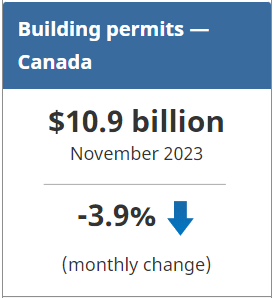Statistics Canada: Building Permits November 2023

The total monthly value of building permits in Canada decreased 3.9% from October to $10.9 billion in November, with declines posted across almost all building type components.

On a constant dollar basis (2017=100), the total value of building permits declined 3.9% to $6.8 billion in November.
Overall modest declines in residential sector
Despite eight provinces with monthly gains in residential construction intentions, the total value of residential permits declined 2.8% overall to $7.0 billion in November.
British Columbia (-19.4%; -$249.3 million) and Quebec (-17.3%; -$231.0 million), both driven by month-over-month declines in the multi-unit component, more than offset the residential gains in the rest of the country in November.
The Atlantic provinces collectively increased 30.0% in residential permit values to $421.8 million in November, the highest monthly value for the region in the first 11 months of 2023. Similarly, in November, the Prairie provinces ($1.4 billion) posted their highest monthly level in the first 11 months of 2023, up 9.8% from October. To round out residential construction intentions in November, the territories increased 10.6% to $7.4 million, while Ontario edged up 2.1% to $3.0 billion.
Less construction intentions in commercial, institutional, and industrial components
The total monthly value of non-residential building permits decreased 5.8% from October to $3.9 billion in November. All three non-residential components declined, with the commercial component decreasing for the third consecutive month, down 3.5% from October.
Permit values in the commercial component have been trending down since the record high of $2.9 billion in March 2023. Year over year, the $1.7 billion value of commercial permits issued in November 2023 was 16.2% less than November 2022 levels.
On a constant dollar basis, commercial construction intentions were down 18.2% year over year in November, while the overall value of non-residential permits declined 10.1%.
To explore data using an interactive user interface, visit the Building permits: Interactive Dashboard.
For more information on construction, please visit the Construction statistics portal.
For more information on housing, please visit the Housing statistics portal.
Statistics Canada has a Housing Market Indicators dashboard. This web application provides access to key housing market indicators for Canada, by province and by census metropolitan area. The indicators are updated automatically with new information from monthly releases, giving users access to the latest data.
Note to readers
Unless otherwise stated, this release presents seasonally adjusted data with current dollar values, which facilitate month-to-month and quarter-to-quarter comparisons by removing the effects of seasonal variations. For information on seasonal adjustment, see Seasonally adjusted data – Frequently asked questions.
With this release, table 34-10-0066 has been archived and replaced by table 34-10-0285. The information from January 2017 onwards that was in table 34-10-0066 is still available in the new table, except for the constant dollar series which have been rebased to 2017 = 100. As a result of the interpolation from the previous deflators to the current deflators (2012 vs. 2017), data for January and February 2017 represent a wedge between these two levels and should be used with caution. This irregularity will be corrected with the release of our annual revision.
Building components
- Single-family dwellings: Residential buildings containing only one dwelling unit (e.g., single-detached house, bungalow, linked home [linked at the foundation]).
- Multi-family dwellings: Residential buildings containing multiple dwelling units (e.g., apartment, apartment condominium, row house, semi-detached house).
- Industrial buildings: Buildings used in the processing or production of goods or related to transportation and communication.
- Commercial buildings: Buildings used in the trade or distribution of goods and services, including office buildings.
- Institutional and government buildings: Buildings used to house public and semi-public services, such as those related to health and welfare, education or public administration, and buildings used for religious services.
Revision
Data are subject to revisions based on late responses, methodological changes and classification updates. Unadjusted data have been revised for the previous month. Seasonally adjusted data have been revised for the previous three months.
For information on trend-cycle data, see the page Trend-cycle estimates – Frequently asked questions.
Next release
Data on building permits for December 2023 will be released on February 6, 2024.
Source: Statistics Canada

